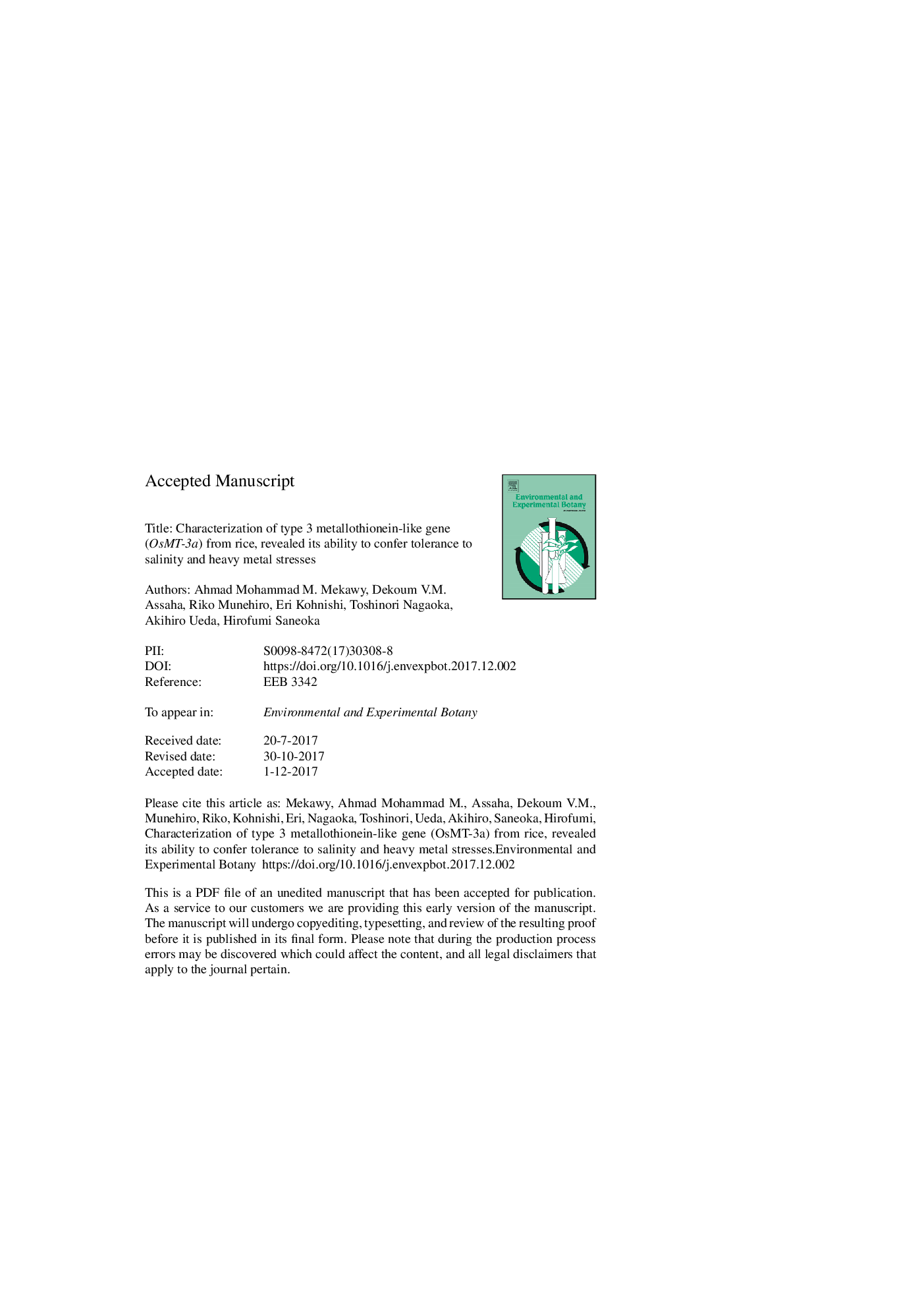| کد مقاله | کد نشریه | سال انتشار | مقاله انگلیسی | نسخه تمام متن |
|---|---|---|---|---|
| 8887107 | 1628030 | 2018 | 36 صفحه PDF | دانلود رایگان |
عنوان انگلیسی مقاله ISI
Characterization of type 3 metallothionein-like gene (OsMT-3a) from rice, revealed its ability to confer tolerance to salinity and heavy metal stresses
دانلود مقاله + سفارش ترجمه
دانلود مقاله ISI انگلیسی
رایگان برای ایرانیان
کلمات کلیدی
موضوعات مرتبط
علوم زیستی و بیوفناوری
علوم کشاورزی و بیولوژیک
بوم شناسی، تکامل، رفتار و سامانه شناسی
پیش نمایش صفحه اول مقاله

چکیده انگلیسی
Salinity is significantly impeding agricultural productivity globally. As an ameliorative strategy, the quest for salinity tolerance genes and pathways to counter this problem is on the rise. In this study, we screened a cDNA library from rice (cultivar Egyptian Yasmine) grown under salinity stress, and isolated a metallothionein-like type 3 (OsMT-3a) gene. The function of the gene was characterized in Escherichia coli cells and its expression was analyzed in two rice cultivars having contrasting salinity tolerance. Overexpression of OsMT-3a in KNabc, salinity-sensitive E. coli mutant cells, showed improved salinity tolerance. The hydrogen peroxide (H2O2) concentration in OsMT-3a-transformed cells was less than one-third of that in control cells under salinity stress conditions. Under high concentrations of external H2O2, OsMT-3a-overexpressing E. coli cells showed enhanced growth, whereas the growth of control cells was completely retarded. Constitutive overexpression of OsMT-3a also showed enhanced E. coli tolerance against metal stress, particularly, for Cd2+ in comparison to control cells, in terms of growth performance. OsMT-3a expression was highly induced by NaCl treatment in the leaves of the salinity-tolerant cultivar Egyptian Yasmine; however, it was not induced in the salinity-sensitive cultivar Sakha 102. The expression of OsMT-3a was also up-regulated by Cd2+ and Cu2+ treatments in the shoots of Egyptian Yasmine with increased accumulation of the metal ions in comparison to Sakha 102. Egyptian Yasmine leaves had lower reactive oxygen species (ROS) (O2â and H2O2) concentrations than Sakha 102 under both NaCl and CdCl2 stress conditions. Collectively, these results suggest that the OsMT-3a gene confers tolerance not only to salinity but also to heavy metal stress, by detoxifying the ROS generated by these stresses. Thus, OsMT-3a would play a key role in salinity tolerance in rice via ROS scavenging.
ناشر
Database: Elsevier - ScienceDirect (ساینس دایرکت)
Journal: Environmental and Experimental Botany - Volume 147, March 2018, Pages 157-166
Journal: Environmental and Experimental Botany - Volume 147, March 2018, Pages 157-166
نویسندگان
Ahmad Mohammad M. Mekawy, Dekoum V.M. Assaha, Riko Munehiro, Eri Kohnishi, Toshinori Nagaoka, Akihiro Ueda, Hirofumi Saneoka,